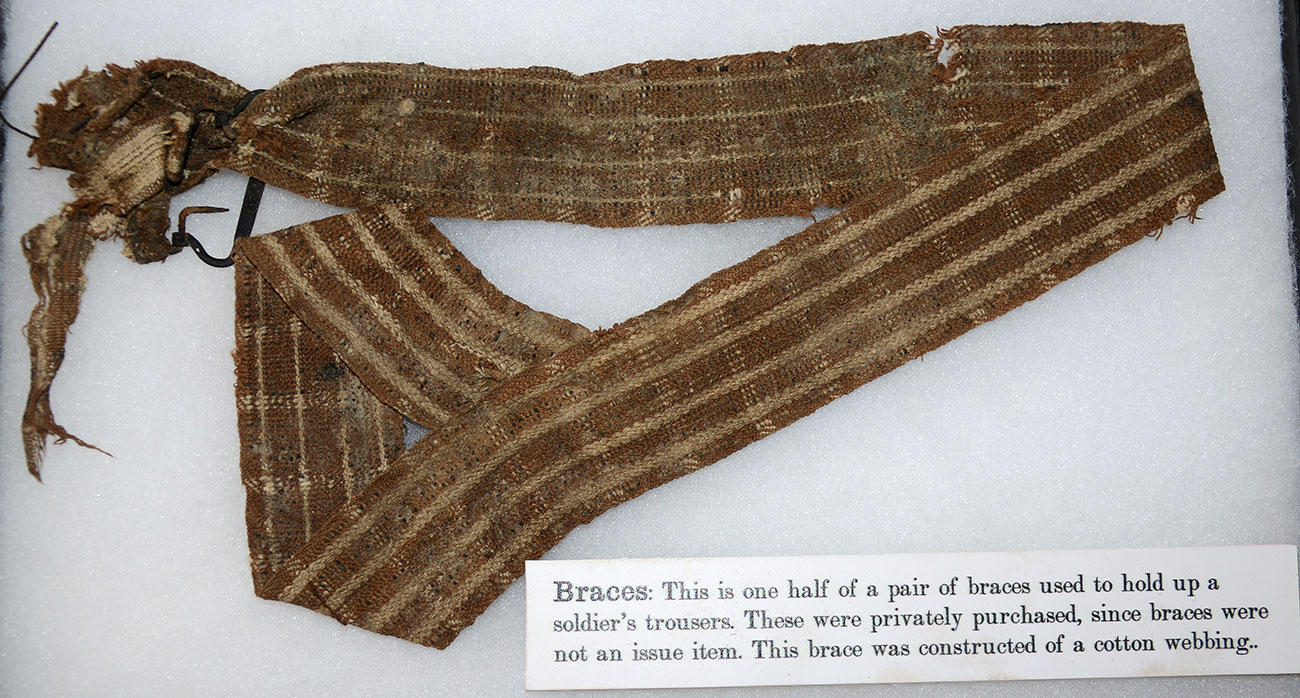site search
online catalog
CIVIL WAR - INDIAN WAR SUSPENDERS FROM FORT PEMBINA, ND

$295.00 SOLD
Quantity Available: None
Item Code: 1052-260
Cotton web suspender strap and buckle. Better known as “braces” during the Civil War period, suspenders were an essential, but not an issue piece of clothing or gear for a soldier since trousers of the period did not have belt loops. That they were not an item of issue by the army comes as a surprise to many, given the neatly uniformed appearance of many movie and television troopers, all with identical suspenders worn over uniform shirts, but the army likely figured any adult male probably owned at least one pair so why supply them. In any case, as a common and not very showy, but very useful item, they were seldom preserved by a soldier and hardly the sort of memento of his service likely to be preserved by a family.
This is a one side of a pair, showing as a brown and white check pattern with part of their black wire adjusting buckle still attached at a slightly shredded end. They look like they had put in some long service before being finally discarded by a soldier at Fort Pembina, ND, a fort established in 1870 and in operation into the 1890s. The condition is quite good and very displayable, coming from a dig conducted on private property with the owner’s permission that has yielded a vast array of artifacts, including wood, leather and even cloth, preserved by the wet anaerobic conditions of the soil, and that cast light on the material culture of a small postwar frontier garrison, who were equipped with Civil War material well into the 1870s and then later patterns as they were adopted and became available for issue.
Situated in the Red River Valley in North Dakota near the Canadian border, Fort Pembina was established in 1870 and in operation until 1895. Trading posts existed earlier in the area as part of the fur trade, and the first U.S. military post there was temporary- manned by a detachment of Minnesota troops in 1863-1864 following the 1862 Sioux uprising. In March 1870 a new fort was established south of the Pembina River and about 200 yards west of the Red River, completed by July and named in honor of Gen. George H. Thomas. The name was changed to Fort Pembina in September and the initial garrison consisted of two companies of the 20th US Infantry. Their main duty was to provide security for settlers worried about Sioux returning south from Canada, but the troops were more occupied with escorting boundary surveys along the Canadian border and preventing Fenian raids heading north into Canada.
The fort included enlistedmen’s barracks, officers’ quarters, guard house, ordnance storehouse, company kitchen, root house, laundress’s quarters, quarters for civilian employees, hospital and hospital servant’s house, a barn for the “hospital cow,” quartermaster and commissary offices and storehouse, stables, wagon shed, etc. The garrison reached peak strength in 1878 af 200, but the average was about 125 enlisted men and 8 officers. An October 1885 return listed 97 men, 2 field pieces, 1 mountain howitzer, 100 rifles, 19 pistols, 23 mules, and 9 wagons. By 1890 the post had just 23 men, and after an 1895 fire destroyed some 19 buildings it was decided to abandon the fort rather than rebuild, the last detachment left in September. The property was turned over to the Interior Department and later sold in 1902.
Period suspenders, like socks, shoes, underwear, or army shirts are not very much to look at, but were essential to the soldier and remarkably hard to find for a collector or museum display. This has the additional benefit of a tight provenance to a U.S. military western post. [sr][ph:L]
~~~~~~~~~~~~~~~~~~~~~~~~~~~~~~~~~~~
THIS ITEM, AS WITH ALL OTHER ITEMS AVAILABLE ON OUR WEB SITE,
MAY BE PURCHASED THROUGH OUR LAYAWAY PROGRAM.
CLICK HERE FOR OUR POLICIES AND TERMS.
THANK YOU!
Inquire About CIVIL WAR - INDIAN WAR SUSPENDERS FROM FORT PEMBINA, ND
For inquiries, please email us at [email protected]
Most Popular
Historical Firearms Stolen From The National Civil War Museum In Harrisburg, Pa »
Theft From Gravesite Of Gen. John Reynolds »
Selection Of Unframed Prints By Don Troiani »
Fine Condition Brass Infantry Bugle Insignia »
Wonderful Condition Original Confederate-Manufactured Kepi For A Drummer Boy Or Child »
featured item
CONFEDERATE GENERAL LUNSFORD LINDSAY LOMAX AS A WEST POINT CADET IN DAGUERREOTYPE BY ANSON CA. 1854/55, EX-BILL TURNER COLLECTION
Formerly in the collection of Virginia collector and dealer Bill Turner this ninth plate cased daguerreotype by Rufus Anson of New York City is extremely clear, nicely cased, has a mat showing the photographer’s name and address, and shows later… (1138-1905). Learn More »
site search
Upcoming Events
The shop will remain closed to the public through Friday, Jan. 24th, re-opening on Saturday, Jan.… Learn More »





